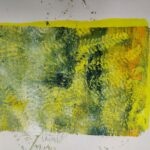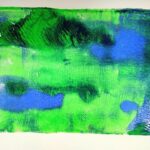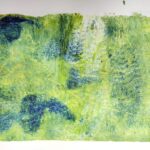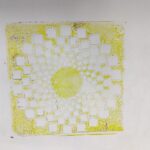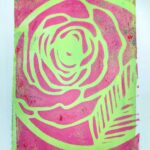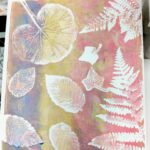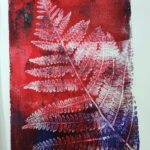Last week I told you about teaching children gel plate printing, which was great fun. This week I want to tell you about teaching adults the same techniques.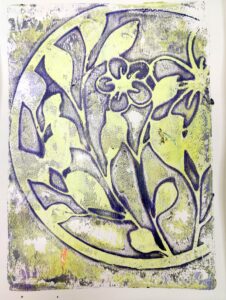
I do really enjoy teaching, regardless of the age of the students, but clearly teaching adults is very different. The children I taught were all aged under ten; most of them were around six years old. At that age they have no fear, there are no expectations and seeing their faces light up when they realise they can make great work is really satisfying. Adults are not the same at all. Most are hesitant and they frequently want to make something amazing right from the start, otherwise they start to tell themselves that they can’t do it.
If you follow me on Instagram or Facebook you will have seen the work some adult students produced in a recent class of mine, and they were stunning pieces. There was nothing for them to be scared of. One lady is a fellow bookbinder, so came to the class to make work for her book covers. Another lady signed up for both the gel plate printing and the journal-making classes and wanted to make inner linings for leather journals. I will cover journal-making in another blog soon.
There are many different approaches to making gel plate prints and you can find lots of people showing how they work on Instagram. Most of the gel plate demos on Instagram show you how to transfer images from magazines. Some will show you how to use leaves to make a single colour print. You won’t usually find anything more complex than that on Instagram but if you Google “gel plate printing” there are lots of demos available showing you different methods and lots of ideas for making these prints more personal.
I prefer not to use magazines when I teach gel plate printing classes; it is simply not a look or result I particularly like. It is all down to personal preference in the end. What I do teach, because it is what I prefer, is how to make prints which have depth.
This is achieved by layering the different colours and stencils on the prints and is not dissimilar to the way I prefer to paint, just as you can see in my artwork. Personally, I feel that layers give a more interesting final result.
I start by showing my students how to apply a thin, but not too thin, layer of paint in their chosen colour and they then make five or six single colour backgrounds. This allows them to get the feel of the plate, paint and roller. It also gives them a feel as to how the paper will pull away from the plate.
Next I provide stencils, although they are not the same ones I use with the children. These are far more delicate and need careful handling, but give amazing results. I then suggest adding two or more colours to a plate to give even more interest, along with another stencil. Then I sit back and watch.
It is important to me that I inspire adults, just like the children and working with students who have never done any printmaking before has to be supportive as well as instructive. We so easily lose confidence as adults when making art. It doesn’t have to be perfect, though, because life isn’t perfect and sometimes when you get it “wrong” you actually achieve the most brilliant results. It is all about letting go and playing.
I would like to reiterate what I said last week about the importance of making art, even if you make a mess and throw it away. The mental health and well-being of every member of our society can be vastly improved by engaging in activities which involve using our hands. It really is so very important.
The list of artistic activities is long. Starting with painting, drawing, printmaking, including monoprinting, screen printing, collotype printing, copper plate etching, aluminium plate etching, stone lithography, illustration and the many forms there are of sculpting. Add to that list the creative crafts available. Knitting, crochet, tapestry, bookbinding, embroidery, lace making, weaving, sewing, gardening, photography, pottery, fashion design, costume design and making, flower arranging. I have left lots of other fabulous activities out, but I think you get the idea.
As I said earlier, one lady made some beautiful pieces of printed artwork which we attached to leather for her to use in making journals for her daughter. She must have been happy with the outcome as she has messaged me to say that she is planning to come again.
I would like to add that whilst I didn’t do any printmaking myself with the adults (I really was there in a supportive capacity), I still learned things myself. The results both ladies achieved were fabulous, but I saw one produce an outcome that I really wasn’t expecting and it’s one that I am planning to have a go at myself.
Teaching is exhausting, not just for me but for most of the artists I know who do it, but it is also rewarding. To watch people go from being scared to squealing with delight when they achieve a particularly good result is the most fantastic feeling. I don’t think, however, that I have the time or stamina to teach every day and I do understand now why many art teachers don’t produce artwork themselves very often.
It can be a huge drain, but it is satisfying when your students produce results like those you can see throughout this blog. I hope you enjoy seeing what they have done and if you fancy trying it yourself, just click onto my website and book a class with me. If the dates on offer are not convenient for you, please do email me as I often have classes on days not shown.
If you have enjoyed reading this post, please like and follow me and please share it with people who you think might be interested. I am always on the lookout for new artists to feature as I know how much everyone enjoys reading about other artists. Also, if you think there is a subject you would like to know more about and would like me to write about, I will be happy to consider it. Sharing, liking and following my blogs increases the number of people the algorithm shows the blogs to, so please share. Thank you in advance for supporting me this way.






